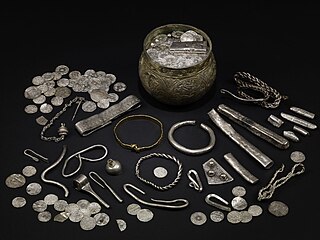
The Slagelse Hoard (Danish : Slagelseskatten), discovered in 1883 beneath a tile floor in a medieval cellar on Smedegade in Slagelse, is the largest medieval gold hoard ever discovered in Denmark.

The Slagelse Hoard (Danish : Slagelseskatten), discovered in 1883 beneath a tile floor in a medieval cellar on Smedegade in Slagelse, is the largest medieval gold hoard ever discovered in Denmark.
The Slagelse Hoard was discovered in 1883 beneath a tile floor in a Medieval basement on Smadegade in Slagelse. [1] It was found by two construction workers. Their reward equalled more than a year's salary. [2]
The hoard consisted of 186 European gold coins (total weight: c. 700 g (25 oz)), 269 European silver coins, four silver bars as well as jewellery (mainly finger rings), buckles and decorative garment components. [3] The youngest coins date from 1372. [1]
It has been suggested that the hoard may be associated with the Danehof in Slagelse in 13876 where Olaf, at just six years old, was elected as the successor to his grandfather Valdemar IV. [1] [3]

The krone is the official currency of Denmark, Greenland, and the Faroe Islands, introduced on 1 January 1875. Both the ISO code "DKK" and currency sign "kr." are in common use; the former precedes the value, the latter in some contexts follows it. The currency is sometimes referred to as the Danish crown in English, since krone literally means crown. Krone coins have been minted in Denmark since the 17th century.

Anja Jul Andersen is a former Danish team handball player and current coach. She is an Olympic champion, World champion and two times European champion. In 1997, she was named IHF World Player of the Year. She is widely regarded as one of the best female handball players of all time. She was admitted to the Danish Sports Hall of Fame in 2007.

Slagelse Municipality is a kommune in Region Zealand on the west coast of the island of Zealand in Denmark. The municipality covers an area of 571 km2. The municipality borders Kalundborg Municipality to the north, Sorø Municipality to the north-east, Næstved Municipality to the south-east and connects to Nyborg Municipality via the Great Belt Bridge.

The Vale of York Hoard, also known as the Harrogate Hoard and the Vale of York Viking Hoard, is a 10th-century Viking hoard of 617 silver coins and 65 other items. It was found undisturbed in 2007 near the town of Harrogate in North Yorkshire, England. The hoard was the largest Viking one discovered in Britain since 1840, when the Cuerdale hoard was found in Lancashire, though the Anglo-Saxon Staffordshire Hoard, found in 2009, is larger.

The Yorkshire Museum is a museum in York, England. It was opened in 1830, and has five permanent collections, covering biology, geology, archaeology, numismatics and astronomy.
The Stanchester Hoard is a hoard of 1,166 Roman coins dating from the fourth to early fifth century found in 2000 at Wilcot, in the Vale of Pewsey, Wiltshire, England. The find was considered important because of the large quantity of unclipped silver coins contained within. It was also the latest dated example of Roman coins found in Wiltshire.

The Silverdale Hoard is a collection of over 200 pieces of silver jewellery and coins discovered near Silverdale, Lancashire, England, in September 2011. The items were deposited together in and under a lead container buried about 16 inches (41 cm) underground which was found in a field by a metal detectorist. It is believed to date to around AD 900, a time of intense conflict between the Anglo-Saxons and the Danish settlers of northern England. The hoard is one of the largest Viking hoards ever discovered in the UK. It has been purchased by Lancashire Museums Service and has been displayed at Lancaster City Museum and the Museum of Lancashire in Preston. It is particularly significant for its inclusion of a coin stamped with the name of a previously unknown Viking ruler.

Strandby is a coastal town in Denmark, located in Region Nordjylland. Its population was 2,307 as of 1 January 2024. It is located at the southern end of Ålbæk Bugt, the bay forming the eastern coast of the northern tip of the North Jutlandic Island, and about 4 km north of Frederikshavn. Strandby has two churches, Strandby Kirke, and a Methodist church.

Viking coinage was used during the Viking Age of northern Europe. Prior to the usage and minting of coins, the Viking economy was predominantly a bullion economy, where the weight and size of a particular metal is used as a method of evaluating value, as opposed to the value being determined by the specific type of coin. By the ninth century, the Viking raids brought them into contact with cultures well familiarised with the use of coins in economies of Europe, hence influencing the Vikings own production of coins.
Airdeconut was a Norse King of Northumbria. Numismatic evidence suggests he was a Christian and he probably ruled in Northern England around the year 900.

Boeslunde is a village on Zealand, in Slagelse Municipality, Region Zealand in Denmark. It is located 7 km north of Skælskør, 9 km east of Korsør and 14 km south of Slagelse.

The Curmsun Disc is a convex-concave gold disc that gained scholarly attention in 2014 after an 11-year-old Polish girl in Sweden showed it to her history teacher. Some scholars have tentatively dated the disc to the 10th to 12th century, although its authenticity is not universally accepted by historians or archaeologists.

Frederik Christian Vilhelm Christesen was a Danish goldsmith and silversmith. His firm was from 1858 based at Amaliegade 11 in Copenhagen.
Mtambwe Kuu or Mtambwe Mkuu is a Medieval Swahili historic site located in Chake Chake District of Pemba North Region. A town wall, a mosque, tombs, and residences are among the several stone constructions at the Mtambwe Mkuu site in northwest Pemba. The oldest indications of occupation date from the eleventh century and persisted successfully and unbrokenly until the fifteenth century. It was once again occupied in the nineteenth century. A cache of over 2,000 gold and silver coins from the 10 and eleventh centuries were found during an excavation at the location, demonstrating Pemba's Swahili involvement in the regional trade networks at the time.
Events in the year 2023 in Denmark.

The Balle Hoard, found in Balle, Djursland, is one of the largest 17th-century hoards ever discovered in Denmark. It consists of 12,121 coins, a silver tankard, a smaller silver cup, jewellery and garment components. The youngest of the coins date from 1658, indicating that the hoard was buried during the early stage of the Second Northern War when Charles X Gustav of Sweden's troops ransacked Jutland.

The Kirial Hoard, found near Kirial, Djursland, is the largest treasure trove ever found in Denmark. It consists of 81,422 silver coins buried in two iron pots and dates from around 1365. Most of the hoard is now on display in the National Museum of Denmark. A minor share of the coins is on display in the local Djursland Museum in Grenå.

The House of the Vestals Hoards, or the Casa delle Vestali Hoards are a set of two coin hoards discovered in and around the House of the Vestals, on the Roman Forum during the late 19th century.